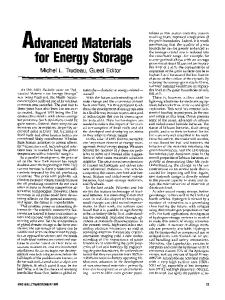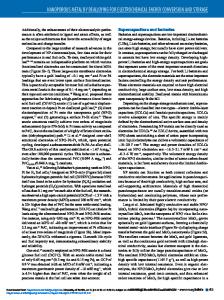Self-assembled materials for electrochemical energy storage
- PDF / 6,350,868 Bytes
- 8 Pages / 585 x 783 pts Page_size
- 36 Downloads / 398 Views
Introduction Continuous depletion of current fossil fuels and environmental pollution caused by them call for the development of green and sustainable energy utilization.1–3 To efficiently use renewable clean energies such as solar and wind, energy-storage technologies are necessary to overcome the intermittent nature of collecting and utilizing these clean energies in daily life.2 Electrochemical energy-storage devices, especially rechargeable batteries and supercapacitors (SCs), have been widely used for energy storage in daily applications, such as portable electronic devices and electric vehicles. These electrochemical energy-storage devices are based on an electron/ion transport and storage mechanism: For commonly used lithium-ion batteries (LIBs) or supercapacitors (SCs), the ion can be reversibly transported between the cathode and anode through the electrolyte, react/intercalate with electrode materials (for LIBs) or be absorbed on the material surface (for SCs). This absorption or reaction of ions with electrode materials generates the current through the external circuit connected with both electrodes, enabling input energy into or output energy from energy-storage systems as charging and discharging. With the ever-increasing demands on higher energy and power density energy-storage devices, developing new material strategies targeting higher capacities, faster kinetics and
improved cycling stability becomes one of the most urgent tasks for next-generation energy-storage technologies.4 These call for the control of materials over multiple length scales from microscopic to macroscopic, in terms of electron/ion transportation through the electrode, electrolyte, and their interface. The self-assembly of particles can span these size scales and hence has become crucial for high performance throughout the entire battery (Figure 1). For example, many kinds of conventional electrode materials, such as lithium nickel manganese cobalt (NMC) oxide cathode material,5 mesocarbon microbead graphite, or composite anode materials6 in LIB, are micrometer-scale secondary clusters that are self-assembled from submicrometer-scale primary particles (Figure 2). The binder and conducting agent of carbon black are also assembled on these electrode material clusters to build a continuous electron conducting network in the electrode.5 Between electrodes, the separators are constructed by assembling the polymer microfibers into a microporous membrane, for electrolyte infiltration and ion transportation while electronically isolating the two electrodes.7 During battery operation, the decomposition products are directly assembled at the interface between electrode and electrolyte, and the stability of this assembled solid–electrolyte interface (SEI) is of great importance for the cycling performance of LIBs.8
Hao Chen, Stanford University, USA; [email protected] Peter Benedek, ETH Zürich, Switzerland; [email protected] Khande-Jaé Fisher, Stanford University, USA; [email protected] Vanessa Wood, ETH Zürich, Switzerland; vwood
Data Loading...











